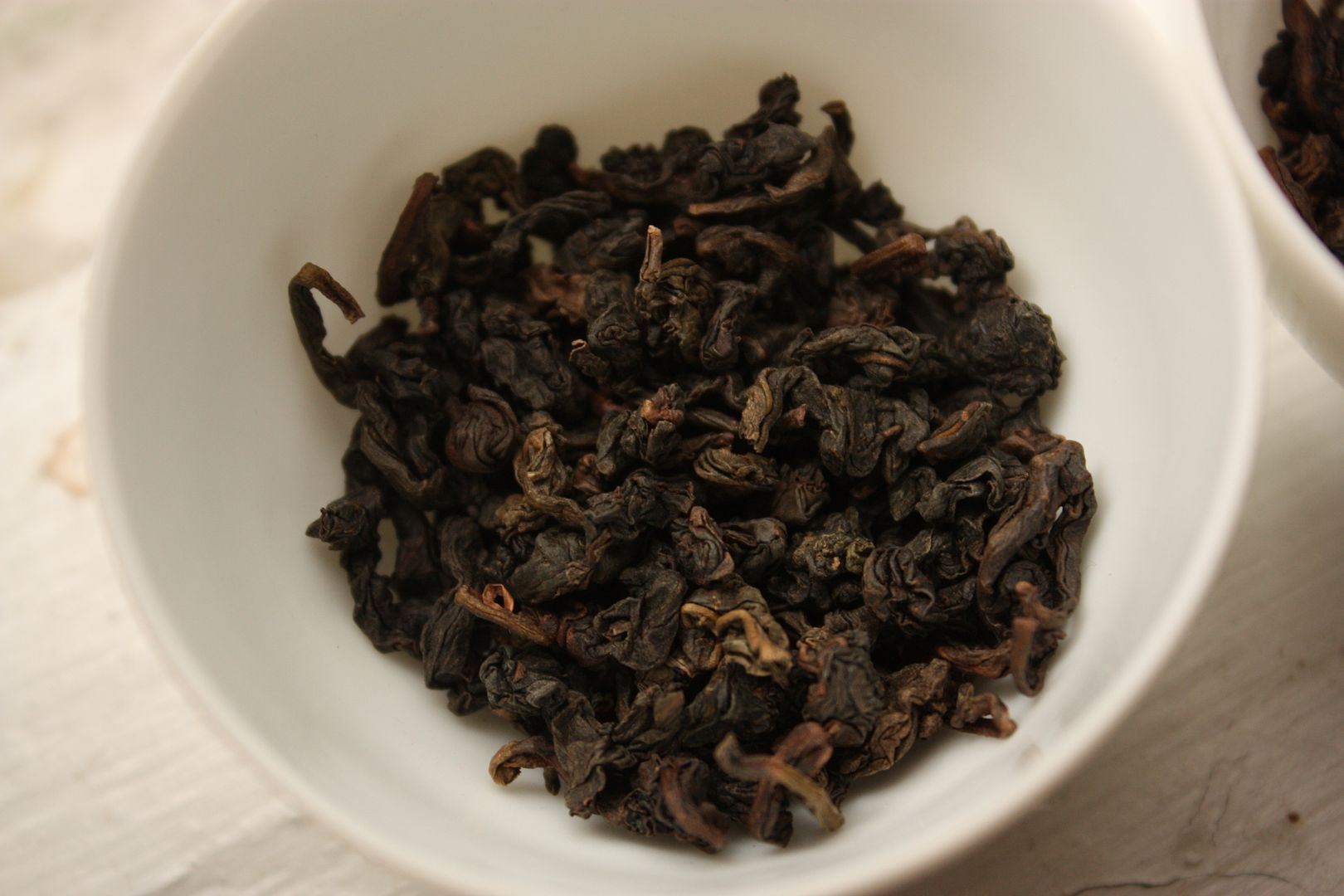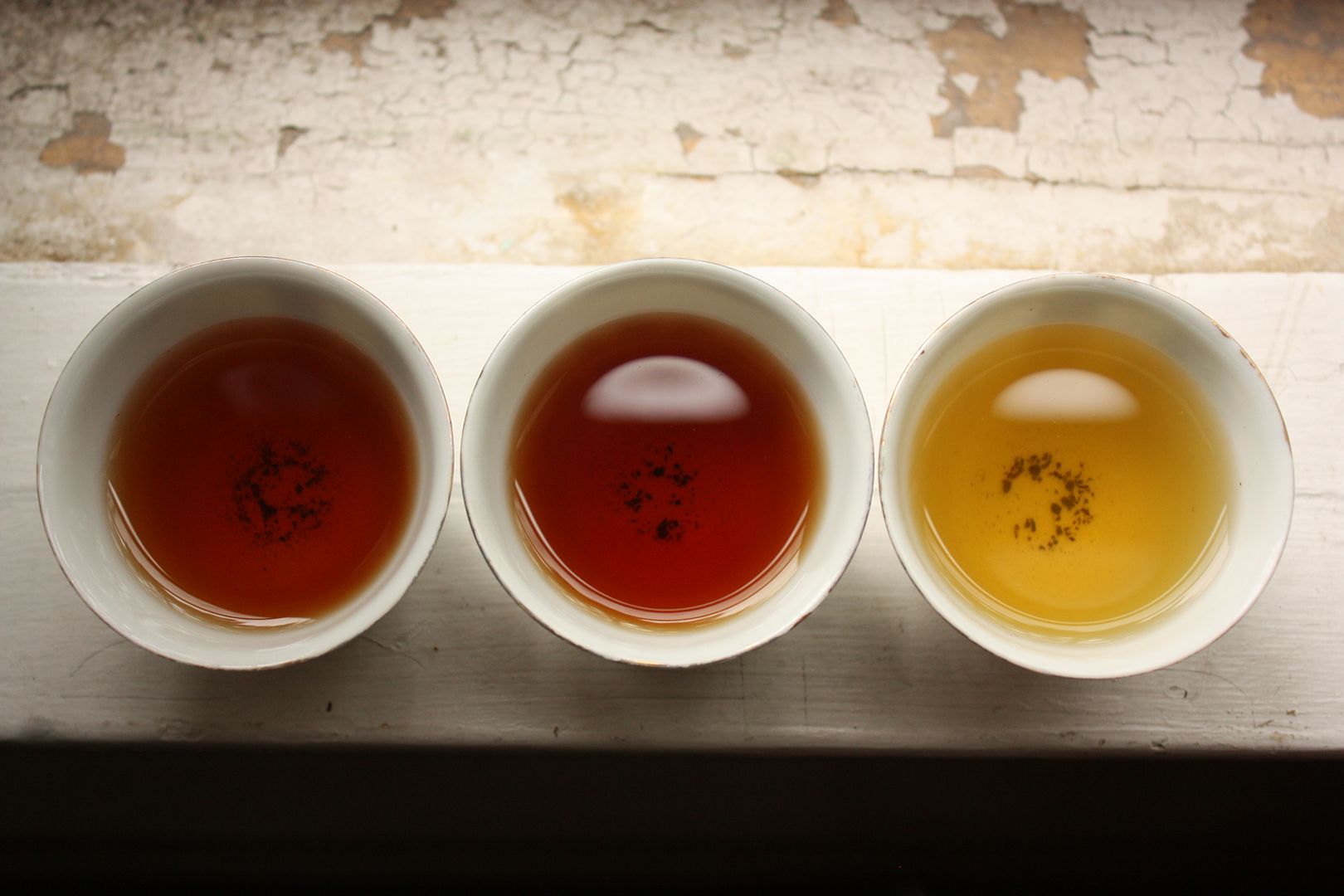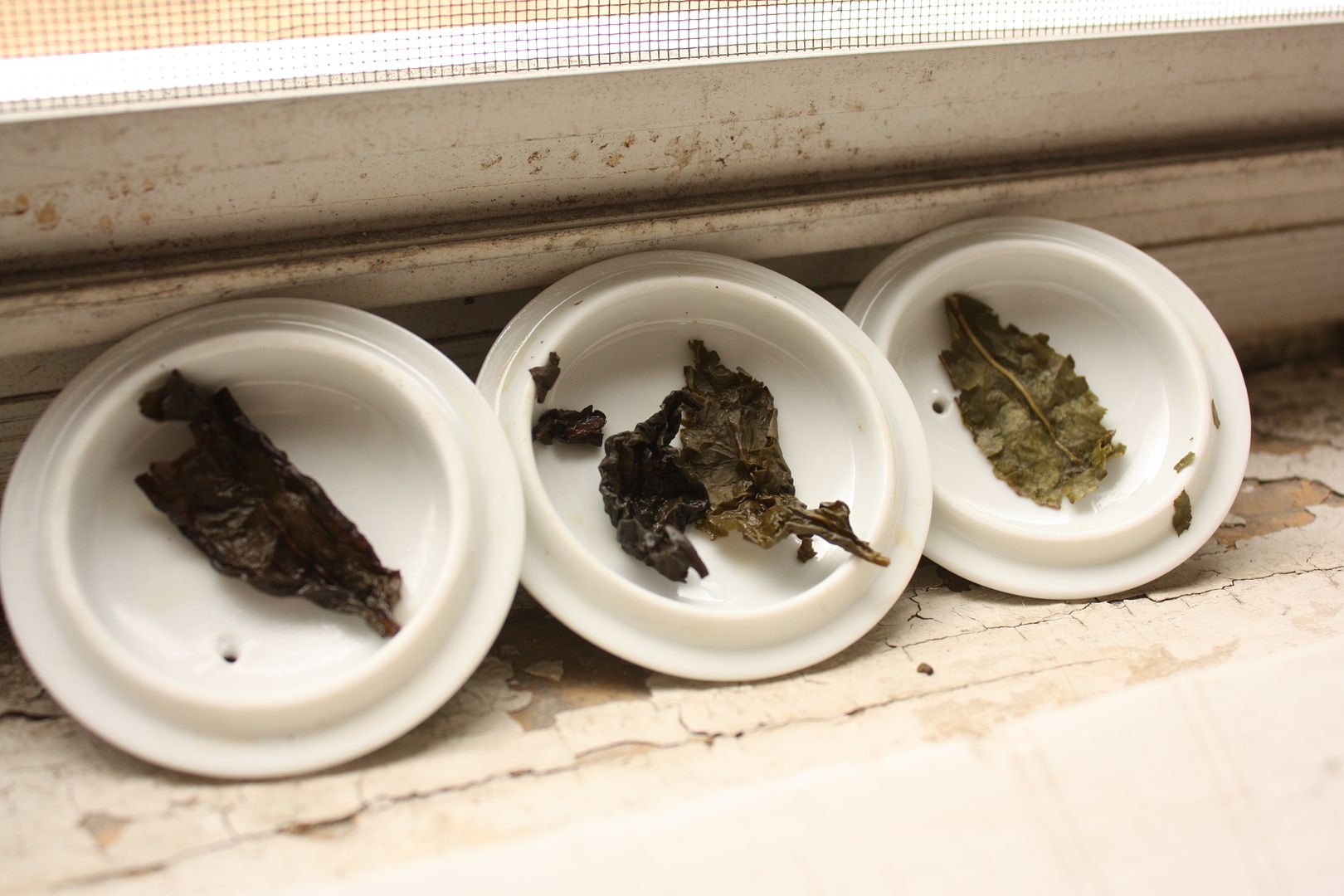I felt inspired to do a comparative tasting today, something which I haven’t done for quite some time. This past March when I went back to Hong Kong I renewed my interest in tieguanyin, which for the past few years have been in the doghouse, so to speak, because most of the stuff you can buy in the US or in mainland China are so unspeakably bad. They are, generally speaking, of the “nuclear green” variety where they are almost greener than green teas. While some people like the fragrance of those teas, I personally find them awful. Give me any traditional style tieguanyin anyday.
Having gone to a few stores that sold such things in Hong Kong this past break, including a great experience with a relatively cheap tieguanyin at the incredible Tim’s Kitchen (yes, restaurant tea can be good!) I was quite inspired. So, I bought a bunch of things, and started trying some that I have leftover at home in comparison. Today’s is one such tasting.
The identity of the teas are not terribly important. The one on the left is a highly roasted, slightly aged (my own storage) oolong that I bought a few years ago. It’s electric roasted. The one in the middle is a recent purchase on this past trip, with the vendor roasting using charcoal roast and blending the end product. The one on the right is what I think of as a typical green tieguanyin these days, still not as green as can be, but pretty green nonetheless. I tend not to drink such things these days.
Closeups of each of the three:
You can see the blending in the middle tea – various colours are present in the dry leaves. I brewed them in competition cups for five minutes each, and this is the result
Competition style really brings out all kinds of stuff you don’t necessarily notice if you were brewing them normally. The middle tea ended up being the darkest, and the nose has a distinct charcoal smell that the other two don’t have. The right one is obviously the most immediately fragrant, with a strong vanilla note. The left one is in some ways the most subdued, but has a nice roasted fragrance.
In the mouth though is where they really differ. I think with competition style, especially if you drink one right after the other, it is sometimes difficult to tell which one is giving you the strong, everlasting aftertaste, because you are drinking them in such quick succession. However, it is possible to distinguish notes and especially body and mouthfeel very easily with this method. Drinking it this way, it is obvious that the middle cup is in some ways the fullest — it has the most full bodied brew among the three. It also has flaws, specifically it has a harsh and sour note, the harshness from the charcoal roast, the sourness from probably some improper storage. The tea on the left is the most pleasant to drink for me, probably because it’s been aged slightly. It has the beginning of an aged taste to it, and will develop it further if I were to leave it alone. However, it is also in some ways the most boring, because the tea is more or less one-note, and is a bit hollow in the mouth. The one on the right is clearly a different beast, and caters to an entirely different market.
The wet leaves also yield some stories. You can see the mixed nature of the tea for the middle one, as there are leaves of varying shades and stiffness, whereas the other two are more uniform in their appearance. The leaves on the left are a bit thin in comparison to the other two, perhaps accounting for some of the thinness that I’m noticing in the cup.
It is difficult to find teas like the two left ones in the US, at least, and in China, even. In a big tea market in a major city, you may find one or two outfits that have some stuff that might be somewhat roasted, but by and large, if you walk into a tieguanyin store you’re going to find various shades of nuclear green. The reason for this is simple. It’s both easier and cheaper to make really green tieguanyin — less work, less processing, and they sell for more in China, where the taste is predominantly for lighter tieguanyins. The same, I think, can be said of the US, and it is usually only serious teaheads who drink the roasted ones, which make them a difficult thing to sell. In places in Southern China like Guangdong province, the tradition of drinking roasted tea is a bit deeper, so you will find more of these types of tea there, but even then you have to look for them, because otherwise it is very easy to end up with inferior roasted teas.
I like the tea in the middle when I drink it normally — the sourness is quite manageable, as evidenced by my session with friends this past weekend. This is the other thing about competition brewing — you want to start with a tea that is both strong and has a good body/mouthfeel. Particular flavours that may be unpleasant are entirely manageable through brewing techniques, but it’s easier for skills to manage bad traits than to concoct a drink out of a bland and boring tea. Likewise, it makes me wonder about the usefulness of drinking single estate teas for any genre — blending requires skills and is an art, and I’m not sure if there are really that many people now who can do it right. I turned down the offer to buy some unblended tieguanyin from the same shop, I should go back next time to do that for comparison.







 RSS - Posts
RSS - Posts
17 responses so far ↓
darwin // April 28, 2011 at 1:59 am |
very nice post! and i totally agree with the nuclear green tgy. i stayed in china for a few years a couple of years back and all they had were very green tgy’s. i do call back to china some time to ask for tea from friends there and i specifically asked a tea merchant in quan zhou (a city in fujian province) for these traditional or high roasted tgy’s and i was given a reply that the tea merchant didnt even know what it was.
im curious though, given the case that its hard to find traditional tgy’s in china, on how hong kong tea shops get their hands on these traditional or high roast tgy’s… do they buy them green from china then roast it themselves in hong kong? or does it come traditionally or high roasted direct from china?
MarshalN // April 28, 2011 at 2:25 am |
The HK shops buy their teas raw and roast it themselves. That’s the only way. Very, very few people in mainland do this sort of work now. Most younger sellers have no clue what you’re talking about, and when you press them they will look at you like you’re an idiot, talking about “nongxiang tieguanyin” as if theirs is not strong enough.
Su Ming Ng // April 29, 2011 at 12:13 am |
It’s been my experience that high roast oolongs particularly charcoal high roasted teas age somewhat more sour than more medium roasted ones.
Di // April 30, 2011 at 9:28 am |
Wow…Tim’s menu looks so good! But are the prices in USD? Killer… X(
MarshalN // April 30, 2011 at 11:09 am |
Oh no, they’re in HKD
Merrisue // May 2, 2011 at 6:26 pm |
I like what you did in your comparison! What a great way to break it down to explain the difference. Can’t wait to see if you do anymore.
BBA // June 23, 2011 at 10:49 am |
Marshaln,
Where can I find a good, traditional style Tieguanyin in Manhattan? I recently moved here and would like to get my hands on one as a starting place.
Thanks!
MarshalN // June 23, 2011 at 10:52 am |
You can try the Tea Gallery
Faustus // June 23, 2011 at 5:48 pm |
Thanks, big help.
BBA // June 25, 2011 at 1:45 pm |
What’s your opinion of Ten Ren, if you don’t mind me asking?
MarshalN // June 25, 2011 at 6:51 pm |
I’d avoid to the best of my abilities
BBA // June 26, 2011 at 3:19 pm |
Thanks.
BBA // June 26, 2011 at 3:23 pm |
I had a bad experience with them – I haven’t been drinking tea long so was not confident that what I got from them was actually bad quality and was just not what I was use to, or if was actually bad.
Changing tastes | A Tea Addict's Journal // June 22, 2012 at 3:29 am |
[…] teas to ones that are more orange than brown. The range of colours of roasted teas can be seen in this post of mine from a little while back, when I tried three different teas with varying levels of roasting […]
florian // June 22, 2012 at 5:26 am |
Hi,
this spring I’ve been back to china, in Guilin province, and at the tea market there I met someone who do himself charcoal roasted wulong. The tea was supervised for 5 years, with two re-roastings per year, and then put it for sale. The leaves he used are from a high mountain area in Hubei province. I trust the man, and after some talk i bought 100g of his tea….quite expensive though. Anyway, if someone wish, i can give his name and phone number…because there are really not many people to know those tea roasting techinques.
Luke // November 12, 2012 at 11:51 am |
Hello marshalN!
I’ve been reading your blog for a while and I hope I can ask you a question to Tie Guan Yin since I don’t know many experts out there who could have the knowledge to answer my question.
I have something like a tea group where we meet every week to drink and test some teas. About TGY we had the discussion about the fragrance. Some of our group do have the opinion that if the fragrance of the tea (whether it is roasted or greenish) is too strong, it might be synthetic. Do you have heard anything about such fake fragrances?
An answer about this question would be highly appreciated!
Best,
Luke
Nick // July 17, 2017 at 8:20 pm |
Hi MarshalN,
I loved this post. For me, I have been a very hardcore Japanese tea drinker for a long time now (and chinese greens to a lesser extent), so obviously love my green teas. However, in the last few years I have gotten into pu-erh and am now diving into oolongs. Surprisingly with my green tea-intensive background I have found that I enjoy more oxidized and roasted oolongs far more than the light floral ones with minimal oxidation. I think this is partly from a desire to branch out into teas that are much different than greens. I’ve had a few traditionally made tieguanyin and really adored them. I can’t quite imagine them being anything else. Having read your article on the greening of oolongs, I’m very glad to know that the market for traditionally made oolongs may be picking up again.
Cheers